ACP 601 Case Study: Analyzing Autism in Educational Context
VerifiedAdded on 2022/11/25
|6
|1520
|478
Case Study
AI Summary
This case study analyzes the educational experiences of a 12-year-old boy, Dom, recently diagnosed with autism. The analysis examines the challenges and issues Dom faces, including anxiety, social difficulties, and behavioral outbursts. The study explores the impact of educational experiences on autistic children, referencing legal standards and the role of schools in providing support. It highlights the importance of visual learning, structured environments, and sensory-friendly resources. The document also discusses knowledge management processes, generational knowledge, and the need for tailored support strategies for autistic students. The author uses research to provide insights into contemporary educational practices for supporting individuals with autism and their carers. The case study emphasizes the importance of understanding the individual's needs and strengths to create effective learning environments.
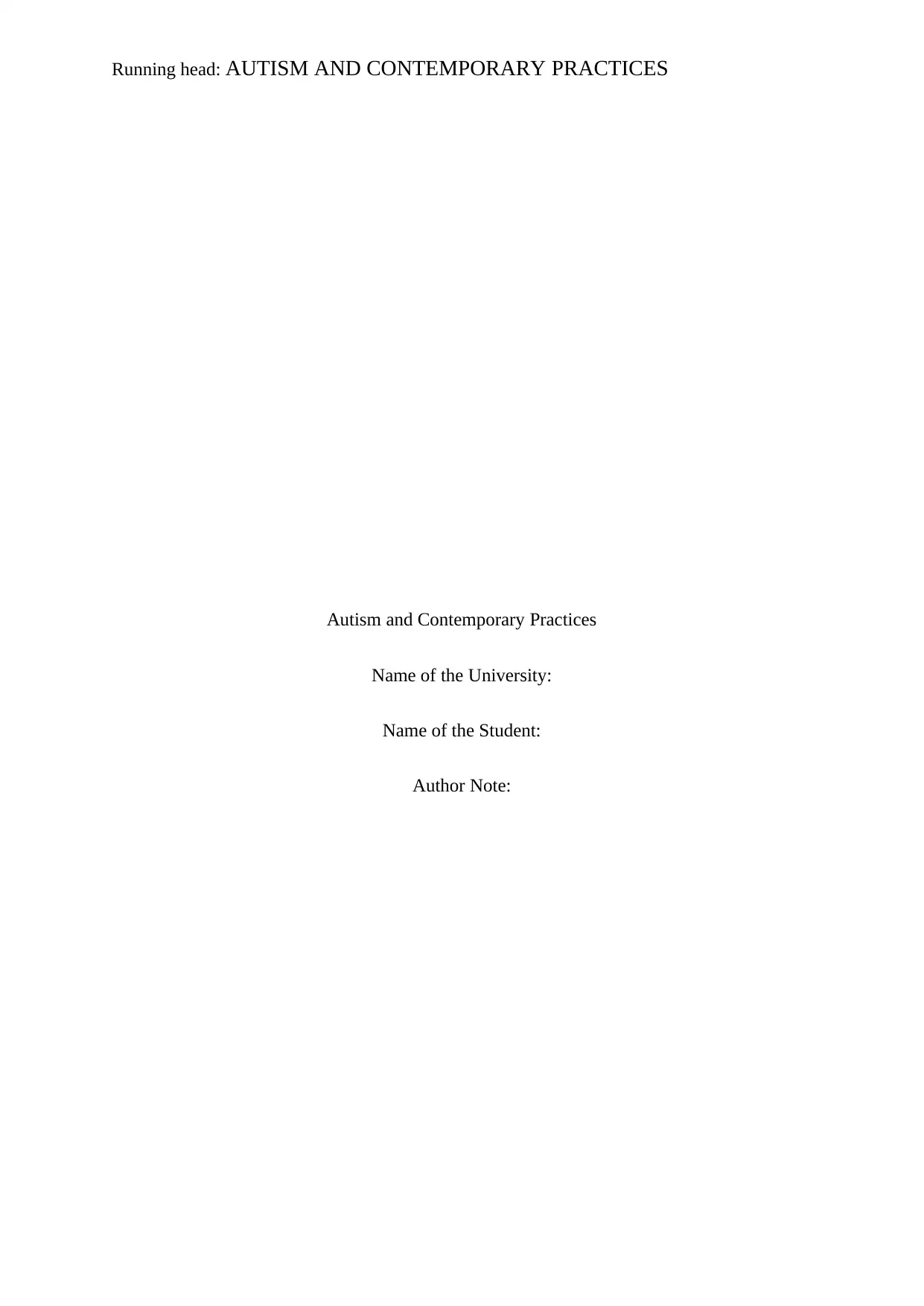
Running head: AUTISM AND CONTEMPORARY PRACTICES
Autism and Contemporary Practices
Name of the University:
Name of the Student:
Author Note:
Autism and Contemporary Practices
Name of the University:
Name of the Student:
Author Note:
Paraphrase This Document
Need a fresh take? Get an instant paraphrase of this document with our AI Paraphraser
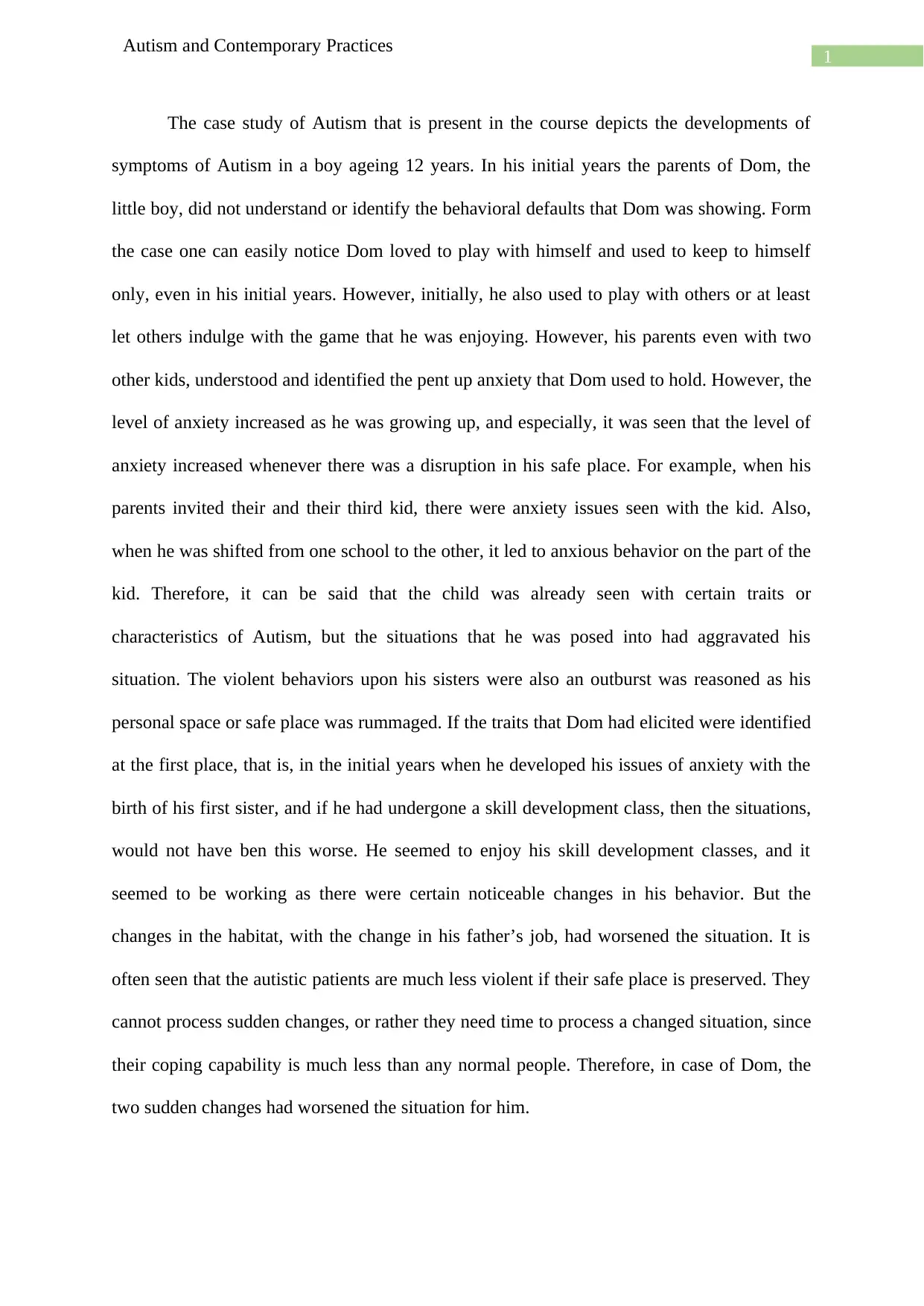
1
Autism and Contemporary Practices
The case study of Autism that is present in the course depicts the developments of
symptoms of Autism in a boy ageing 12 years. In his initial years the parents of Dom, the
little boy, did not understand or identify the behavioral defaults that Dom was showing. Form
the case one can easily notice Dom loved to play with himself and used to keep to himself
only, even in his initial years. However, initially, he also used to play with others or at least
let others indulge with the game that he was enjoying. However, his parents even with two
other kids, understood and identified the pent up anxiety that Dom used to hold. However, the
level of anxiety increased as he was growing up, and especially, it was seen that the level of
anxiety increased whenever there was a disruption in his safe place. For example, when his
parents invited their and their third kid, there were anxiety issues seen with the kid. Also,
when he was shifted from one school to the other, it led to anxious behavior on the part of the
kid. Therefore, it can be said that the child was already seen with certain traits or
characteristics of Autism, but the situations that he was posed into had aggravated his
situation. The violent behaviors upon his sisters were also an outburst was reasoned as his
personal space or safe place was rummaged. If the traits that Dom had elicited were identified
at the first place, that is, in the initial years when he developed his issues of anxiety with the
birth of his first sister, and if he had undergone a skill development class, then the situations,
would not have ben this worse. He seemed to enjoy his skill development classes, and it
seemed to be working as there were certain noticeable changes in his behavior. But the
changes in the habitat, with the change in his father’s job, had worsened the situation. It is
often seen that the autistic patients are much less violent if their safe place is preserved. They
cannot process sudden changes, or rather they need time to process a changed situation, since
their coping capability is much less than any normal people. Therefore, in case of Dom, the
two sudden changes had worsened the situation for him.
Autism and Contemporary Practices
The case study of Autism that is present in the course depicts the developments of
symptoms of Autism in a boy ageing 12 years. In his initial years the parents of Dom, the
little boy, did not understand or identify the behavioral defaults that Dom was showing. Form
the case one can easily notice Dom loved to play with himself and used to keep to himself
only, even in his initial years. However, initially, he also used to play with others or at least
let others indulge with the game that he was enjoying. However, his parents even with two
other kids, understood and identified the pent up anxiety that Dom used to hold. However, the
level of anxiety increased as he was growing up, and especially, it was seen that the level of
anxiety increased whenever there was a disruption in his safe place. For example, when his
parents invited their and their third kid, there were anxiety issues seen with the kid. Also,
when he was shifted from one school to the other, it led to anxious behavior on the part of the
kid. Therefore, it can be said that the child was already seen with certain traits or
characteristics of Autism, but the situations that he was posed into had aggravated his
situation. The violent behaviors upon his sisters were also an outburst was reasoned as his
personal space or safe place was rummaged. If the traits that Dom had elicited were identified
at the first place, that is, in the initial years when he developed his issues of anxiety with the
birth of his first sister, and if he had undergone a skill development class, then the situations,
would not have ben this worse. He seemed to enjoy his skill development classes, and it
seemed to be working as there were certain noticeable changes in his behavior. But the
changes in the habitat, with the change in his father’s job, had worsened the situation. It is
often seen that the autistic patients are much less violent if their safe place is preserved. They
cannot process sudden changes, or rather they need time to process a changed situation, since
their coping capability is much less than any normal people. Therefore, in case of Dom, the
two sudden changes had worsened the situation for him.
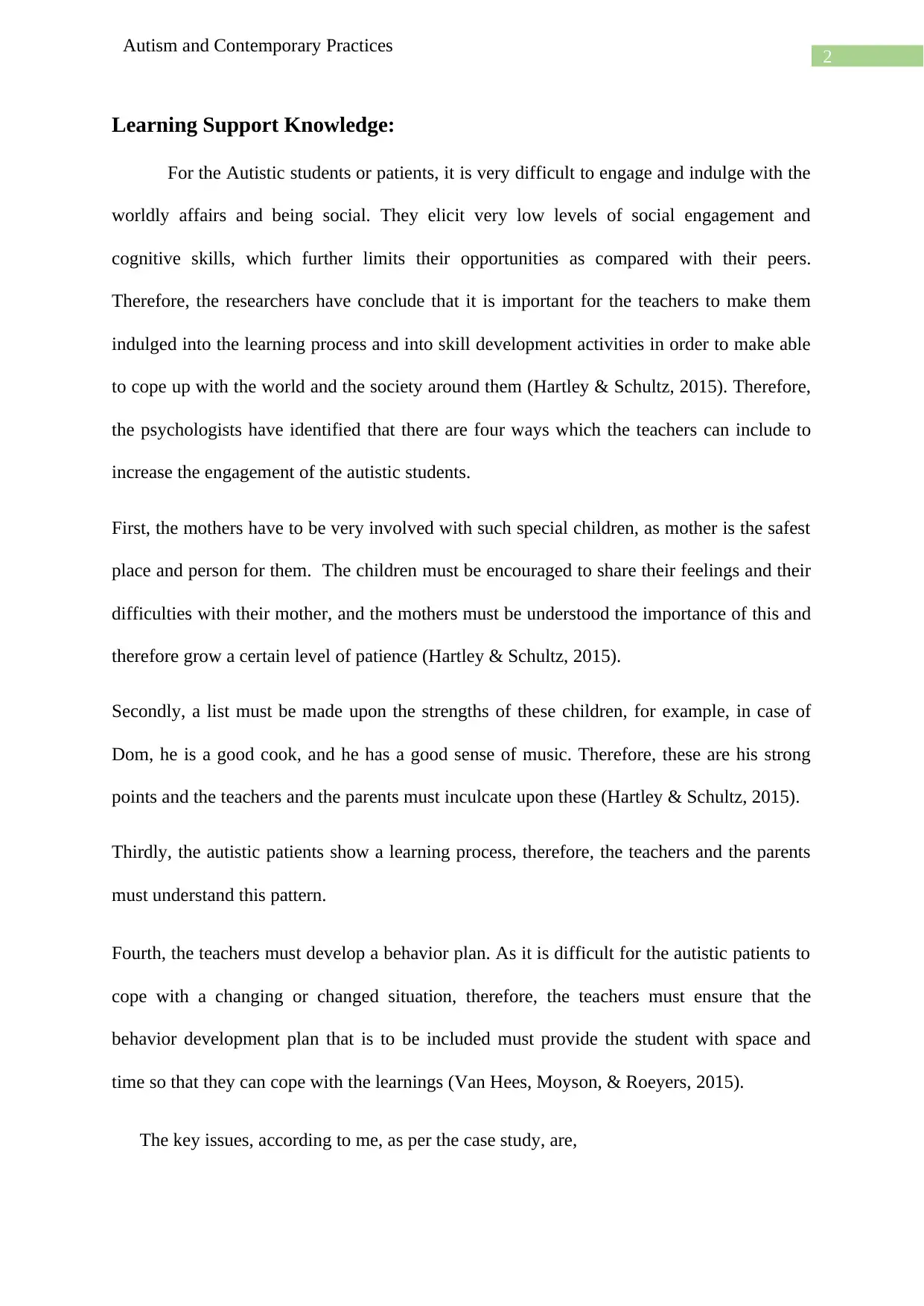
2
Autism and Contemporary Practices
Learning Support Knowledge:
For the Autistic students or patients, it is very difficult to engage and indulge with the
worldly affairs and being social. They elicit very low levels of social engagement and
cognitive skills, which further limits their opportunities as compared with their peers.
Therefore, the researchers have conclude that it is important for the teachers to make them
indulged into the learning process and into skill development activities in order to make able
to cope up with the world and the society around them (Hartley & Schultz, 2015). Therefore,
the psychologists have identified that there are four ways which the teachers can include to
increase the engagement of the autistic students.
First, the mothers have to be very involved with such special children, as mother is the safest
place and person for them. The children must be encouraged to share their feelings and their
difficulties with their mother, and the mothers must be understood the importance of this and
therefore grow a certain level of patience (Hartley & Schultz, 2015).
Secondly, a list must be made upon the strengths of these children, for example, in case of
Dom, he is a good cook, and he has a good sense of music. Therefore, these are his strong
points and the teachers and the parents must inculcate upon these (Hartley & Schultz, 2015).
Thirdly, the autistic patients show a learning process, therefore, the teachers and the parents
must understand this pattern.
Fourth, the teachers must develop a behavior plan. As it is difficult for the autistic patients to
cope with a changing or changed situation, therefore, the teachers must ensure that the
behavior development plan that is to be included must provide the student with space and
time so that they can cope with the learnings (Van Hees, Moyson, & Roeyers, 2015).
The key issues, according to me, as per the case study, are,
Autism and Contemporary Practices
Learning Support Knowledge:
For the Autistic students or patients, it is very difficult to engage and indulge with the
worldly affairs and being social. They elicit very low levels of social engagement and
cognitive skills, which further limits their opportunities as compared with their peers.
Therefore, the researchers have conclude that it is important for the teachers to make them
indulged into the learning process and into skill development activities in order to make able
to cope up with the world and the society around them (Hartley & Schultz, 2015). Therefore,
the psychologists have identified that there are four ways which the teachers can include to
increase the engagement of the autistic students.
First, the mothers have to be very involved with such special children, as mother is the safest
place and person for them. The children must be encouraged to share their feelings and their
difficulties with their mother, and the mothers must be understood the importance of this and
therefore grow a certain level of patience (Hartley & Schultz, 2015).
Secondly, a list must be made upon the strengths of these children, for example, in case of
Dom, he is a good cook, and he has a good sense of music. Therefore, these are his strong
points and the teachers and the parents must inculcate upon these (Hartley & Schultz, 2015).
Thirdly, the autistic patients show a learning process, therefore, the teachers and the parents
must understand this pattern.
Fourth, the teachers must develop a behavior plan. As it is difficult for the autistic patients to
cope with a changing or changed situation, therefore, the teachers must ensure that the
behavior development plan that is to be included must provide the student with space and
time so that they can cope with the learnings (Van Hees, Moyson, & Roeyers, 2015).
The key issues, according to me, as per the case study, are,
⊘ This is a preview!⊘
Do you want full access?
Subscribe today to unlock all pages.

Trusted by 1+ million students worldwide
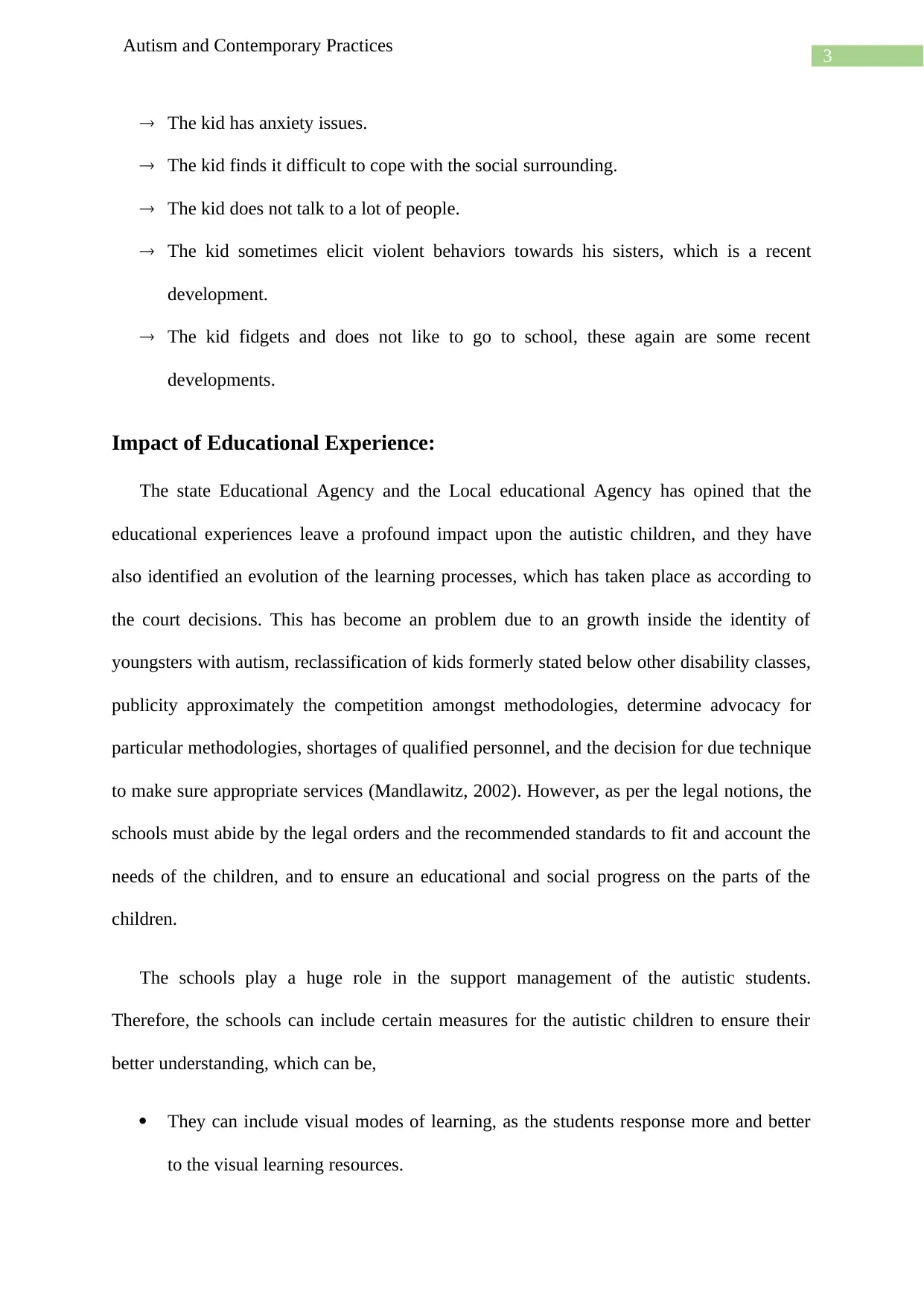
3
Autism and Contemporary Practices
The kid has anxiety issues.
The kid finds it difficult to cope with the social surrounding.
The kid does not talk to a lot of people.
The kid sometimes elicit violent behaviors towards his sisters, which is a recent
development.
The kid fidgets and does not like to go to school, these again are some recent
developments.
Impact of Educational Experience:
The state Educational Agency and the Local educational Agency has opined that the
educational experiences leave a profound impact upon the autistic children, and they have
also identified an evolution of the learning processes, which has taken place as according to
the court decisions. This has become an problem due to an growth inside the identity of
youngsters with autism, reclassification of kids formerly stated below other disability classes,
publicity approximately the competition amongst methodologies, determine advocacy for
particular methodologies, shortages of qualified personnel, and the decision for due technique
to make sure appropriate services (Mandlawitz, 2002). However, as per the legal notions, the
schools must abide by the legal orders and the recommended standards to fit and account the
needs of the children, and to ensure an educational and social progress on the parts of the
children.
The schools play a huge role in the support management of the autistic students.
Therefore, the schools can include certain measures for the autistic children to ensure their
better understanding, which can be,
They can include visual modes of learning, as the students response more and better
to the visual learning resources.
Autism and Contemporary Practices
The kid has anxiety issues.
The kid finds it difficult to cope with the social surrounding.
The kid does not talk to a lot of people.
The kid sometimes elicit violent behaviors towards his sisters, which is a recent
development.
The kid fidgets and does not like to go to school, these again are some recent
developments.
Impact of Educational Experience:
The state Educational Agency and the Local educational Agency has opined that the
educational experiences leave a profound impact upon the autistic children, and they have
also identified an evolution of the learning processes, which has taken place as according to
the court decisions. This has become an problem due to an growth inside the identity of
youngsters with autism, reclassification of kids formerly stated below other disability classes,
publicity approximately the competition amongst methodologies, determine advocacy for
particular methodologies, shortages of qualified personnel, and the decision for due technique
to make sure appropriate services (Mandlawitz, 2002). However, as per the legal notions, the
schools must abide by the legal orders and the recommended standards to fit and account the
needs of the children, and to ensure an educational and social progress on the parts of the
children.
The schools play a huge role in the support management of the autistic students.
Therefore, the schools can include certain measures for the autistic children to ensure their
better understanding, which can be,
They can include visual modes of learning, as the students response more and better
to the visual learning resources.
Paraphrase This Document
Need a fresh take? Get an instant paraphrase of this document with our AI Paraphraser
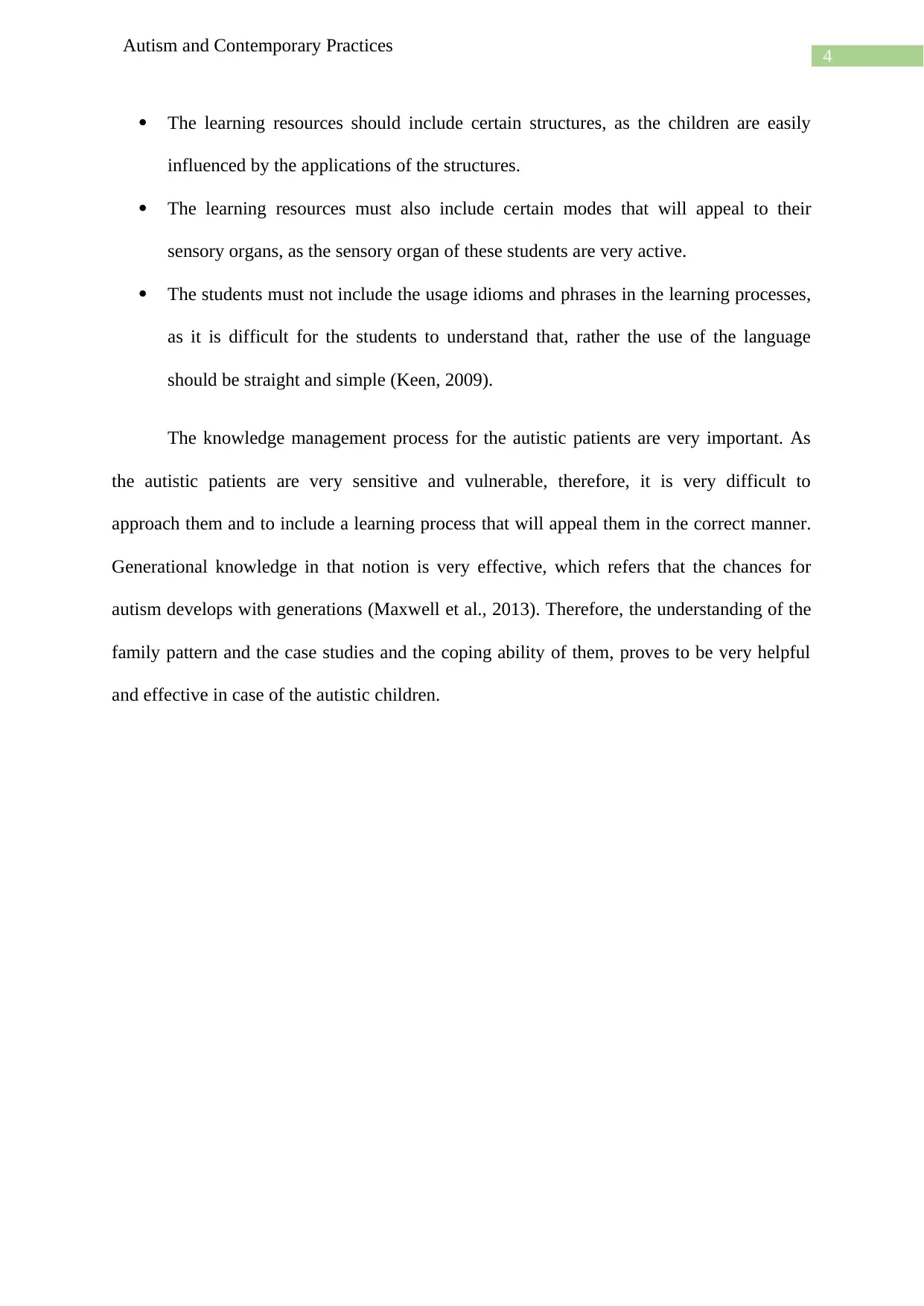
4
Autism and Contemporary Practices
The learning resources should include certain structures, as the children are easily
influenced by the applications of the structures.
The learning resources must also include certain modes that will appeal to their
sensory organs, as the sensory organ of these students are very active.
The students must not include the usage idioms and phrases in the learning processes,
as it is difficult for the students to understand that, rather the use of the language
should be straight and simple (Keen, 2009).
The knowledge management process for the autistic patients are very important. As
the autistic patients are very sensitive and vulnerable, therefore, it is very difficult to
approach them and to include a learning process that will appeal them in the correct manner.
Generational knowledge in that notion is very effective, which refers that the chances for
autism develops with generations (Maxwell et al., 2013). Therefore, the understanding of the
family pattern and the case studies and the coping ability of them, proves to be very helpful
and effective in case of the autistic children.
Autism and Contemporary Practices
The learning resources should include certain structures, as the children are easily
influenced by the applications of the structures.
The learning resources must also include certain modes that will appeal to their
sensory organs, as the sensory organ of these students are very active.
The students must not include the usage idioms and phrases in the learning processes,
as it is difficult for the students to understand that, rather the use of the language
should be straight and simple (Keen, 2009).
The knowledge management process for the autistic patients are very important. As
the autistic patients are very sensitive and vulnerable, therefore, it is very difficult to
approach them and to include a learning process that will appeal them in the correct manner.
Generational knowledge in that notion is very effective, which refers that the chances for
autism develops with generations (Maxwell et al., 2013). Therefore, the understanding of the
family pattern and the case studies and the coping ability of them, proves to be very helpful
and effective in case of the autistic children.
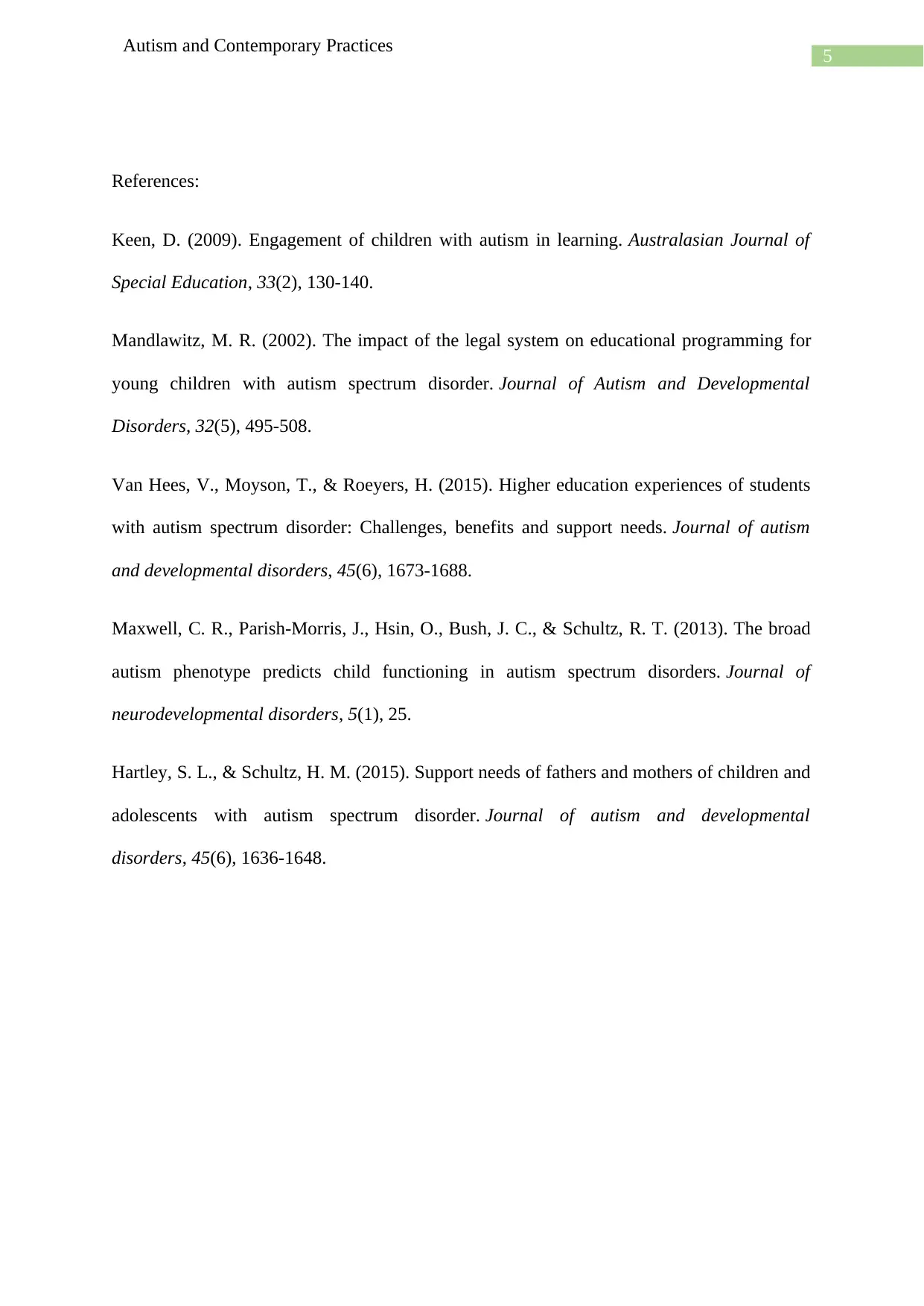
5
Autism and Contemporary Practices
References:
Keen, D. (2009). Engagement of children with autism in learning. Australasian Journal of
Special Education, 33(2), 130-140.
Mandlawitz, M. R. (2002). The impact of the legal system on educational programming for
young children with autism spectrum disorder. Journal of Autism and Developmental
Disorders, 32(5), 495-508.
Van Hees, V., Moyson, T., & Roeyers, H. (2015). Higher education experiences of students
with autism spectrum disorder: Challenges, benefits and support needs. Journal of autism
and developmental disorders, 45(6), 1673-1688.
Maxwell, C. R., Parish-Morris, J., Hsin, O., Bush, J. C., & Schultz, R. T. (2013). The broad
autism phenotype predicts child functioning in autism spectrum disorders. Journal of
neurodevelopmental disorders, 5(1), 25.
Hartley, S. L., & Schultz, H. M. (2015). Support needs of fathers and mothers of children and
adolescents with autism spectrum disorder. Journal of autism and developmental
disorders, 45(6), 1636-1648.
Autism and Contemporary Practices
References:
Keen, D. (2009). Engagement of children with autism in learning. Australasian Journal of
Special Education, 33(2), 130-140.
Mandlawitz, M. R. (2002). The impact of the legal system on educational programming for
young children with autism spectrum disorder. Journal of Autism and Developmental
Disorders, 32(5), 495-508.
Van Hees, V., Moyson, T., & Roeyers, H. (2015). Higher education experiences of students
with autism spectrum disorder: Challenges, benefits and support needs. Journal of autism
and developmental disorders, 45(6), 1673-1688.
Maxwell, C. R., Parish-Morris, J., Hsin, O., Bush, J. C., & Schultz, R. T. (2013). The broad
autism phenotype predicts child functioning in autism spectrum disorders. Journal of
neurodevelopmental disorders, 5(1), 25.
Hartley, S. L., & Schultz, H. M. (2015). Support needs of fathers and mothers of children and
adolescents with autism spectrum disorder. Journal of autism and developmental
disorders, 45(6), 1636-1648.
⊘ This is a preview!⊘
Do you want full access?
Subscribe today to unlock all pages.

Trusted by 1+ million students worldwide
1 out of 6
Your All-in-One AI-Powered Toolkit for Academic Success.
+13062052269
info@desklib.com
Available 24*7 on WhatsApp / Email
![[object Object]](/_next/static/media/star-bottom.7253800d.svg)
Unlock your academic potential
Copyright © 2020–2025 A2Z Services. All Rights Reserved. Developed and managed by ZUCOL.